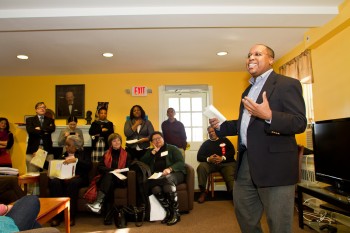Ira De A. Reid House Rededicated

Garry Jenkins '92, a member of the Haverford College Board of Managers, reflects on diversity in higher education at the re-dedication of the Ira De A. Reid House.
Details
Haverford's Ira De A. Reid House, known as the Black Cultural Center, was celebrated on Saturday with a rededication, a reception and discussion in honor of Dr. Reid, the center's namesake. The afternoon celebration on February 9 began in the House, where speakers discussed the importance of the building on campus, and wrapped up in the Whitehead Campus Center, where an Alumni of Color panel discussion raised issues surrounding diversity and higher education.
According to Office of Multicultural Affairs (OMA) Dean and Director Theresa Tensuan, the past year has been an important one for the Black Cultural Center. Discussions last spring about a possible change in use for the space sparked vehement student opinion that the house should remain a residence and cultural center.
To help fully realize the potential of Reid House, the building underwent renovations last summer to make it handicap accessible, and was explicitly designated a community space where students can have meetings and gather for events.“I see this year as a kind of reanimation of the Ira deA. Reid House,” Tensuan said,“And I have to credit this year's residents for bringing the house through this transition.”
Saturday's reception kicked off with an official welcome from Black Student League (BSL) co-heads Dawit Habtemariam '15 and Sarah Puryear '15, who spoke briefly about Dr. Reid, an esteemed professor of sociology at Haverford and the College's first black tenured professor, and discussed some of the activities taking place in the house this year, including BSL events.
Dean of the College Martha Denney discussed the history of the Ira De A. Reid House, which was originally dedicated exactly 20 years ago, in 1993. She explained that part of Dr. Reid's legacy is“a commitment to making our society here and society at large a better place.” Denney went on to say that the college has a great opportunity with this house to meet that mission.
Another speaker at the reception, Garry Jenkins '92, reflected that Haverford taught him the value of diversity and that diversity starts with leadership.“When I think about higher education, it's ultimately about leadership,” he said,“We want people who will go out and change the world, and Haverford prepares you to do that.”
Candace Jordan '12 reflected on her work in the College's Office of Academic Resources. She discussed the sense of community building, especially for students of color, that she feels has been increasing in her time at the college and as an alumna now working with students. She listed several ways that alumni can stay connected to the Haverford community and be resources for students.“Current students must think more broadly of the Haverford network than just their peers,” Jordan said.
Following the reception, the Alumni of Color panel brought together four Fords from different decades. Sarah Willie-LeBreton '86, a Swarthmore College sociology professor, moderated the discussion, framing several questions for the panelists to answer about their experiences as Haverford students of color, including advice they would give their freshmen selves.
Panelist Tiffany Johnston '09 addressed the culture shock she experienced when she came to Haverford, particularly regarding the workload and academic expectations. She advised students of color to make use of all the resources for support at their disposal, especially friends and mentors.
Nicole Myers-Turner '97 described her initial experience of Haverford as“a cold splash.” Her freshman year, the school was abuzz about an Honor Council trial (given the pseudonym“Charlie,”) that raised questions about the qualifications of accepted students of color.“I came in thinking the institution had everything figured out,” said Myers-Turner, currently a Ph.D. candidate in history at the University of Pennsylvania.“I realized you have to bring your critiques and challenges to the institution. It's not your burden as a person of color, but your gift to the institution as a person of color.”
Jim Parabue '72 spoke about arriving at Haverford in 1968 and joining a class that was the first in the college's history to have a sizeable number of African-American students. Talking to College faculty later on, Parabue, now an attorney, realized that there had been no plan in place to support the new students of color; the plan, he says, was to let these students matriculate and go through Haverford just like any other students. But, he said,“People can't all go through and come out the same, they don't come in the same!”
“Our goal should be to build a sense of community, even post-Haverford,” he said.“We need to not break off, not fragment—but to have these hard conversations that allow the community to grow.”
Finally, Iain Haley Pollock '00, a poet and teacher, talked about founding a student group on campus, Sons of Africa, which he found key to building a sense of community. Pollock urged the audience to think of the college as an adapting, growing entity.“Haverford is ultimately made up of people, and those people are changeable,” he said.“The college will adapt to what its students are saying.”
LeBreton wrapped up the panel discussion with the observation that, as the college pushes towards an increasingly diverse faculty and student body, there will always be some discomfort as people learn to live with each other. “But Haverford is unique,” she said,“because it has a built-in infrastructure to deal with the initial discomfort—the Honor Code. That will guide us, because we cannot be excellent if we are not diverse.”
—Prarthana Jayaram '10



